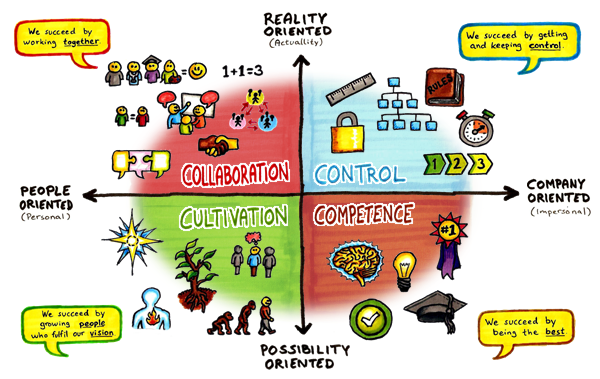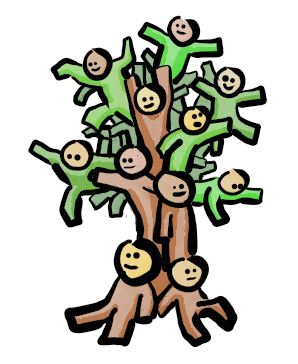1. Awareness
Why it matters
One aspect of culture is our beliefs. What do we regard as true? How do we believe we need to act to succeed? Another aspect of culture is what behaviours are rewarded and which are reprimanded?
Being aware of the current cultures of your organization is important in order to change it.
Schneider’s Culture Model is one tool one can use to understand the dominating culture you as an organization have today, as well as articulating what culture you believe is important for success in the future. Do we “win” by unleashing creativity through inclusive collaboration? Do we win by getting and being in control? Do we succeed by growing people and unleashing their potential? Do we succeed through mastery and by being the best?

Schneider’s Culture Model
And there are other definitions. Edgar Shein defines culture as:
The accumulated, shared learning of a group as it solves its problems, external adaptation and/or internal integration, which has worked well enough to be considered valid and, therefore, to be taught to new members as the correct way to perceive, think, feel, and behave in relation to those problems. Further, “this accumulated learning is a pattern or system of beliefs, values, and behavioral norms that come to be taken for granted as basic assumptions and eventually drop out of awareness.”
In essence, this means what a group learns in order to be successful in an environment, and the beliefs it decides to pass to others.
Once we have a clear vision of what kind of organizational culture we want to see and experience, we can compare it to what we have today and start our work of evolving it.
But the first step is awareness of our current cultures.
How it works
Practice 1: Map behaviours that are rewarded

Every single person wants to feel valued and is constantly paying attention to what behaviours and actions are appreciated and which are not. We desire to fit in. We try to learn how to play “the game”.
This is a strong driver of culture and important to understand. Explore and research what behaviours are promoted. How do people believe they need to behave and react in order to be shown appreciation and receive rewards, such as promotions or public recognition?
Good question to ask might be:
What do you believe you are evaluated on when your manager sets your salary?
When people get public recognition, what have they done?
When people are let go of, what do you believe are the most common reasons?
Practice 2: Map what skills the system makes people practice
To be successful in my role, in the meetings I attend, the processes I take part of – what skills and behaviours do I have to practice and be the master of?
Do these skills and behaviours match the ones we want to see? Do our ways of working promote behaviours and traits we value, or is the system encouraging habits, manners and responses we perceive as bad or unwanted?
Good questions to ask might be:
What is the best approach to make things happen here?
Is it more important to get things done, or get things right?
What traits do you appreciate in your colleagues?
What behaviours are frowned upon?
Practice 3: Explore perceptions
How do employees describe the culture to friends? What stories do they tell? What words do they choose to describe the vibe and atmosphere of the workplace ?
What about former employees? How do they describe the values and habits of the organization?
References
The Reengineering Alternative, William Schneider, 2000
The Culture of Agility, Pete Behrens, Slideshare
Organisational Culture & Leadership, Schein Edgar, Wiley, 2016
